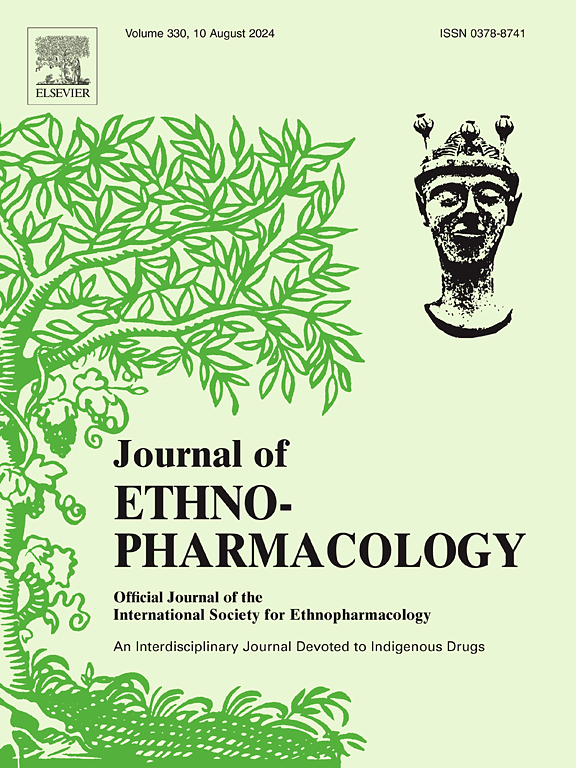Yin-chen Wu-ling powder inhibits MAPKs/CXCL1/CXCR2-induced neutrophil infiltration to alleviate LPS/D-GalN-induced acute liver failure
IF 4.8
2区 医学
Q1 CHEMISTRY, MEDICINAL
引用次数: 0
Abstract
Ethnopharmacological relevance
Acute liver failure (ALF) is the result of progression from acute liver injury with high mortality, and novel treatments are needed. Yin-chen Wu-ling powder (YWP), a traditional herbal medicine in China, has been used for treating acute liver injury for thousands of years. However, the mechanism of YWP is unknown.
Aim of the study
In vitro and in vivo studies were conducted to clarify YWP's protective effect on ALF and investigate its hepatoprotective mechanism.
Materials and methods
We established an LPS/D-GalN-induced ALF mouse model and in vitro system to evaluate the effect of YWP. We characterized YWP's chemical composition via UHPLC-Q-Exactive Orbitrap HRMS. Enzyme-linked immunosorbent assay, hematoxylin and eosin staining, immunohistochemistry and immunofluorescence, flow cytometry, qPCR, Western blot were used to discover key mechanisms both in vitro and in vivo.
Results
YWP alleviated liver dysfunction and liver necrosis. YWP reduced hepatocyte death and inflammatory responses. Importantly, YWP markedly inhibited neutrophil infiltration into the liver. We examined key chemokines that contribute to neutrophil recruitment. The results showed that YWP inhibited CXCL1, which is sourced from inflammation-activated hepatocytes. In addition, YWP inhibited TNF-α-induced CXCL1 transcription via the inhibition of MAPKs signaling in vitro. Furthermore, the anti-ALF effect of YWP was weakened when CXCL1/CXCR2 signaling was suppressed.
Conclusion
YWP alleviates inflammatory liver injury in ALF by suppressing neutrophil infiltration into the liver, potentially through inhibition of the MAPKs/CXCL1/CXCR2 axis. We suggest that YWP is a potential anti-inflammatory treatment for ALF.
阴陈五灵散抑制MAPKs/CXCL1/ cxcr2诱导的中性粒细胞浸润,减轻LPS/ d - galn诱导的急性肝衰竭。
民族药理学相关性:急性肝衰竭(ALF)是急性肝损伤进展的结果,死亡率高,需要新的治疗方法。阴陈五灵散(YWP)是中国的一种传统草药,用于治疗急性肝损伤已有数千年的历史。然而,YWP的机制尚不清楚。研究目的:通过体外和体内实验,阐明YWP对ALF的保护作用,探讨其肝保护机制。材料与方法:建立LPS/ d - galn诱导的ALF小鼠模型和体外系统,评价YWP的作用。采用UHPLC-Q-Exactive Orbitrap HRMS对YWP的化学成分进行了表征。采用酶联免疫吸附法、苏木精和伊红染色法、免疫组织化学和免疫荧光法、流式细胞术、qPCR、Western blot等方法,探索体外和体内的关键机制。结果:黄芪多糖可减轻肝功能障碍和肝坏死。YWP降低了肝细胞死亡和炎症反应。重要的是,YWP显著抑制中性粒细胞向肝脏的浸润。我们研究了促进中性粒细胞募集的关键趋化因子。结果表明,YWP抑制来自炎症激活肝细胞的CXCL1。此外,YWP在体外通过抑制MAPKs信号通路抑制TNF-α-诱导的CXCL1转录。此外,当CXCL1/CXCR2信号被抑制时,YWP的抗alf作用减弱。结论:YWP通过抑制中性粒细胞向肝脏的浸润,可能通过抑制MAPKs/CXCL1/CXCR2轴来减轻ALF的炎症性肝损伤。我们认为YWP是一种潜在的抗炎治疗ALF的方法。
本文章由计算机程序翻译,如有差异,请以英文原文为准。
求助全文
约1分钟内获得全文
求助全文
来源期刊

Journal of ethnopharmacology
医学-全科医学与补充医学
CiteScore
10.30
自引率
5.60%
发文量
967
审稿时长
77 days
期刊介绍:
The Journal of Ethnopharmacology is dedicated to the exchange of information and understandings about people''s use of plants, fungi, animals, microorganisms and minerals and their biological and pharmacological effects based on the principles established through international conventions. Early people confronted with illness and disease, discovered a wealth of useful therapeutic agents in the plant and animal kingdoms. The empirical knowledge of these medicinal substances and their toxic potential was passed on by oral tradition and sometimes recorded in herbals and other texts on materia medica. Many valuable drugs of today (e.g., atropine, ephedrine, tubocurarine, digoxin, reserpine) came into use through the study of indigenous remedies. Chemists continue to use plant-derived drugs (e.g., morphine, taxol, physostigmine, quinidine, emetine) as prototypes in their attempts to develop more effective and less toxic medicinals.
 求助内容:
求助内容: 应助结果提醒方式:
应助结果提醒方式:


